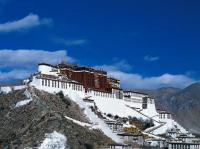Traditional Chinese Paintings
The roots of traditional Chinese painting can be traced back to paintings on Neolithic pottery, such as figures of fish, frogs, deer, birds, flowers, tree leaves and dances, 6000-7000 years old. The earliest Chinese characters were pictographs. Since similar tools and lines were used for the earliest painting and writing, painting is said to have the same origin as calligraphy. Thus, Chinese painting has an outstanding characteristic, that is to say, poetry or calligraphy are inscribed on paintings so that three are integrated, giving people a keener enjoyment of beauty.
Many ancient Chinese paintings were executed on walls or decorative screens. Today, murals can be seen in tombs of the Han, Tang and other dynasties. Gu Kaizhi, a famous painter of the Jin Dynasty, was good at presenting historical themes. His painting "The Nymph of the Luo River" portrayed poet Cai Zhi's meeting with the goddess. The Tang and Song dynasties were the golden age of Chinese painting. The Tang painter Wu Daozi, called the "Sage Painter", was an expert at figure and landscape painting. "Along the River During the Qingming Festival", a genre painting of significant historical value done by the Northern Song Dynasty painter Zhang Zeduan, depicts the bustling scene in the then capital during the Qingming festival. The Tang painters Li Sixun and Li Zhaodao, who were father and son, used mineral substances as pigment to paint landscape paintings, which were called “magnificent landscapes.” Wang Wei practiced watercolor painting with vigorous strokes depicting floating clouds and flowing water. Flower-and-bird painting is also an important traditional Chinese painting genre.
Contemporary painters have specialties. Some only paint figures of ladies, and some only paint animals, or even one kind of animal, such as cats, donkeys, or horses. As a result, the more they paint, the better their paintings become.The Chinese painting world is very active. The China Art Gallery and other art galleries hold individual or joint art exhibitions year in, year out. Also, exhibitions of traditional Chinese paintings have been held in Japan, the Republic of Korea, Singapore, the U.S., Canada, and Europe. Different from Western oil paintings, traditional Chinese painting attracts foreign virtuosos and collectors with its Eastern artistic beauty.
China has also made great progress in Western-style painting, such as oil painting, woodcut, and water colours. Many Chinese painters have created works that combine traditional Chinese painting techniques with those of the West, adding splendour to Chinese painting.
Famous Chinese Paintings
Chinese paintings feature some of the world's longest held artistic disciplines and traditions. These paintings with an array of distinctive oriental styles record China's long history and reflect its beautiful landscapes. The following are the 10 most famous paintings of China, in no particular order.
Along the River During the Qingming Festival
"Along the River During the Qingming Festival" is a panoramic painting by Zhang Zeduan, an artist in the Northern Song Dynasty (960-1127). It is the only existing masterpiece from Zhang, and has been collected by the Palace Museum in Beijing as a national treasure.

(part)
Dwelling in the Fuchun Mountains
"Dwelling in the Fuchun Mountains" is the magnum opus and one of the few surviving works by the painter Huang Gongwang in the Yuan Dynasty (1271-1368). Many consider him a member of the "four great masters of the Yuan." He spent his last years in the Fuchun Mountains near Hangzhou and completed this painting in 1350.

Noble Ladies in Tang Dynasty
"Noble Ladies in Tang Dynasty" are a serial of paintings drawn by Zhang Xuan and Zhou Fang, two of the most influential figure painters during the Tang dynasty (618–907), when the paintings of noble ladies became very popular.
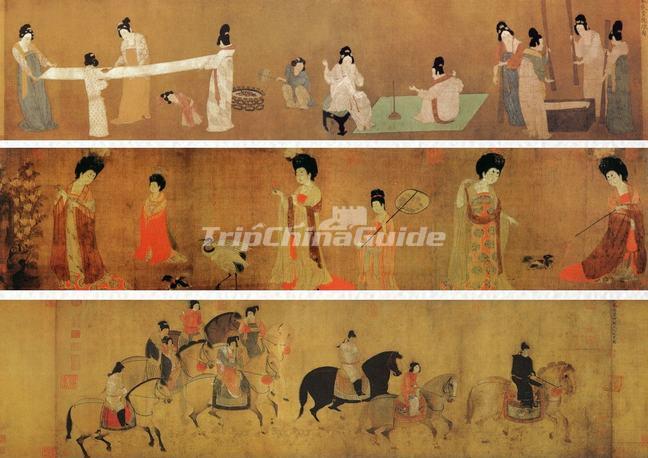
(part)
Emperor Taizong Receiving the Tibetan Envoy
"Emperor Taizong Receiving the Tibetan Envoy" painter Yan Liben was one of the most revered Chinese figure painters in the early years of the Tang dynasty (618–907). The painting is a work of both historical and artistic value, collected by the Palace Museum in Beijing.
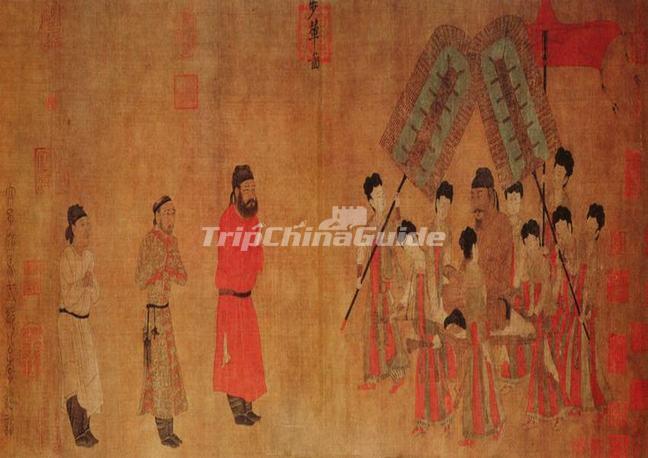
Nymph of the Luo River
"Nymph of the Luo River" by Gu Kaizhi of Eastern Jin Dynasty (317-420) illustrates a romantic poem by Cao Zhi from the state of Wei during the Three Kingdoms period. The copy collected by the Palace Museum in Beijing is a facsimile of the original made during the Song Dynasty (960-1279).
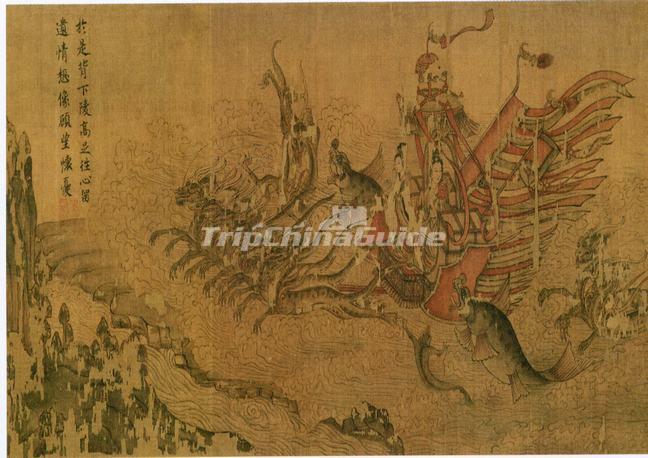
(part)
Spring Morning in the Han Palace
"Spring Morning in the Han Palace" was drawn by Qiu Ying, who specialized in the gongbi brush technique. He was regarded as one of the Four Great Masters of the Ming Dynasty (1368-1644).
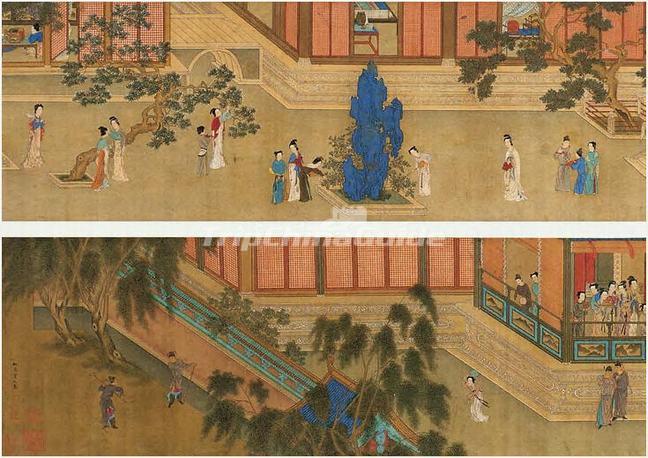
(part)
A Thousand Li of Rivers and Mountains
"A Thousand Li of Rivers and Mountains" by Wang Ximeng, Northern Song Dynasty (960-1127), is a landscape painting masterpiece of ancient China. It is now part of the collection of the Palace Museum in Beijing.

Han Xizai Gives A Night Banquet
"Han Xizai Gives A Night Banquet" is a scroll drawn by Gu Hongzhong, a painter in the Five Dynasties and Ten Kingdoms period (907-960). It is now housed in the Palace Museum in Beijing.
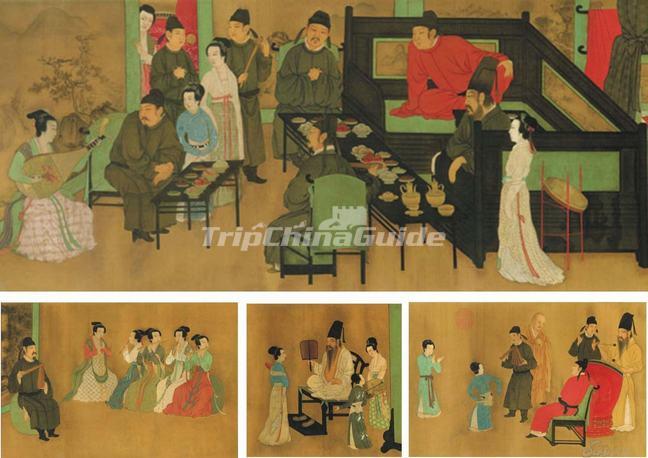
Five Oxen
"Five Oxen" is a painting by Han Huang, a prime minister in the Tang Dynasty (618–907). The painting was lost during the occupation of Beijing by the Eight-Nation Alliance in 1900 and later recovered from a collector in Hong Kong during the early 1950s. Now it is stored in the Palace Museum in Beijing.
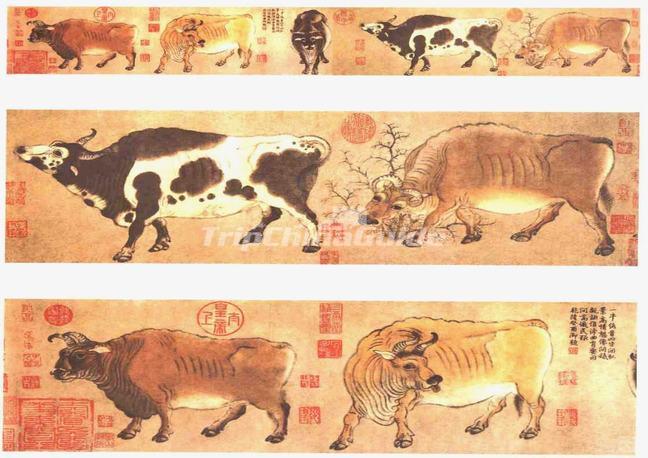
One Hundred Horses
"One Hundred Horses" was drawn by Lang Shining in Qing Dynasty (1644-1911). Lang was a missionary from Italy with birth name Giuseppe Castiglione. Working as a court painter in China for over 50 years, his talent in painting was regarded highly by Chinese emperors Kangxi, Yongzheng and Qianlong. He helped to create a hybrid style that combined the Western realism with traditional Chinese composition and brushwork.
(part)









